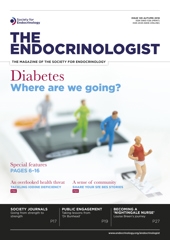We learned at our March Public Engagement Committee meeting that the Society had arranged for Dr Bunhead to come and run a 1-day public engagement training event, to coincide with the 2018 Endocrine Academy, held in April in Birmingham.
This news soon had Miles Levy and I frantically scrabbling for our phones for that inevitable Google search to identify ‘Dr Bunhead’. It wasn’t long before we were presented with images of a ‘wacky’ scientist in an orange jumpsuit with 3-foot plumes of pyrotechnics coming out of his ears; at that moment, we knew Society members were going to be in for something completely different!
The man behind the orange jumpsuit is in fact the showman Tom Pringle, a TV stunt scientist better known for his appearances on Sky One’s Brainiac: Science Abuse and other shows such as Blue Peter. Tom, as well as being renowned as a pioneer of performance-science shows, also runs immersive training programmes in science communication and public engagement.
So I booked myself onto the training day partly out of curiosity about how Tom would bring a completely fresh perspective to public engagement, and partly to network with other Society members looking to develop new and exciting ways of communicating our passion for endocrinology to the wider public.
During the train journey to Birmingham International from Reading, I wondered what to expect. Had we let ourselves in for dressing up in orange jumpsuits, having our heads set on fire or breathing in strange gases (as witnessed in Tom’s YouTube video antics, with the warning ‘Do not try this at home’)?
‘We knew Society members were going to be in for something completely different!’
As it turned out, we were greeted by a more casually dressed Tom, who cordially introduced himself simply as Tom rather than Dr Bunhead. And there were no orange jumpsuits in sight!
Nonetheless, something still told me that we were going to be in for a pretty immersive experience. I was right, and we were certainly kept on our toes throughout the rest of the day, with lots of opportunities to test out and practice a whole lot of new presentation techniques and approaches together.
Tom’s background is in theatre, and we jumped straight in with some theatrical techniques. These may feel a little outside the comfort zone of many scientists, but in fact provided quite a refreshing outlook. We all need to communicate our research or get our message across to patients, which is all about engagement and ensuring understanding. We learned that what we say and how we say it are both important and are expressed and interpreted using whole-body communication, through our mind, body movements and feelings.
Therefore, making people feel comfortable, having the appropriate eye contact and acknowledging the response of your audience are essential skills to develop. Just as in theatre, we learnt to develop hooks to grab the attention of our audience.
We practised developing these by evolving simple language to express our own areas of endocrine interest, which remained factually accurate and could be placed in context with things we already know. For example, how would you explain ‘ghrelin is a stomach hormone that has an orexigenic effect’ to primary school children? Maybe ‘a substance made in your tummy that makes you feel hungry’, which could also be elaborated on using appropriate body visual movements of rubbing your tummy or demonstrating the feeling of being hungry: a bit like playing charades.
‘The technique of having your audience raise their hands and make louder ‘beeping’ sounds when they felt you were no longer giving them the eye contact they deserved will still stick in my mind.’
Likewise, using simple improvised everyday props found in the room were helpful in telling our stories: finding a pen to use as a hypodermic needle to demonstrate blood being taken or a plastic cup to represent the ‘collection’ of a urine sample.
I valued the one and half minute presentations we were asked to give about our work. It made us think hard about what we should include in our message and how we should express ourselves, particularly if we were talking to the media. However, in addition, imagine doing this in the form of a ‘Chinese whisper’, where the next person must recant your story, but in a much shorter timeframe. Contracting the description from 30 seconds, to 7 and then to 3 seconds was not only great for developing a final headline about our work, but also for demonstrating how our message was understood. Certainly, I thought this would be very useful for any PhD student and a great way to decide final thesis titles.
Even as a ‘seasoned’ lecturer, the technique of having your audience raise their hands and make louder ‘beeping’ sounds when they felt you were no longer giving them the appropriate attention or the eye contact they deserved will still stick in my mind, particularly when I give my next large class lecture!
All in all, I was very impressed with meeting Dr Bunhead face to face (even without the pyrotechnics) for what was an enlightening and thought-provoking insight into the world of public engagement. I would highly recommend members to sign up for any future public engagement events. There was something for everyone to take away, whether they had been feeling like a nervous novice or a seasoned presenter, in order to help develop life skills and your career.
Nigel Page, Public Engagement Committee member and Endocrine Ambassador Director of Learning and Teaching, School of Life Sciences, Pharmacy and Chemistry, Kingston University London






